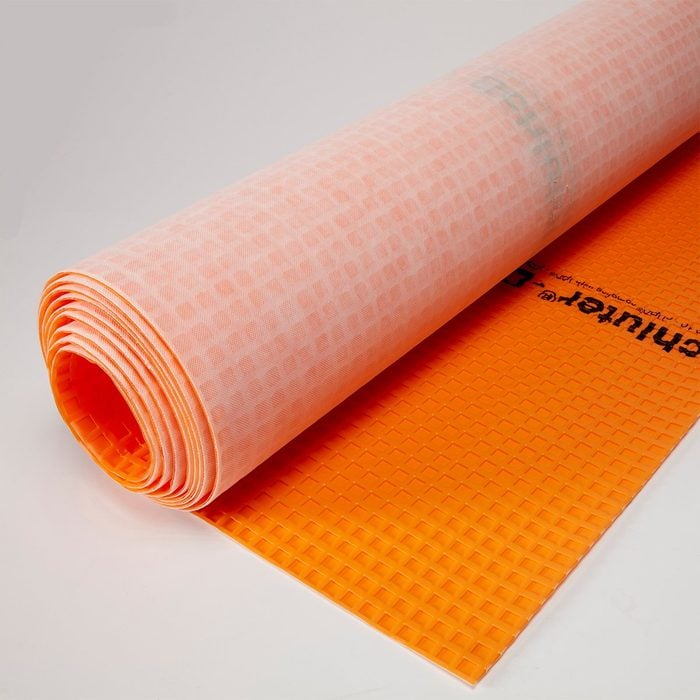Learn the pros and cons of various tile substrate products so you know which to pick for your next project.
Pros and Cons of Various Tile Backers

Dry-Pack Mortar
This is the traditional tile backer. First, felt paper is stapled to the floor and covered with expanded metal lath. Then cement, sand and water are mixed together to a crumbly consistency and floated over the lath to form a flat surface.
Given the complexity, it’s easy to see why even experienced tile setters avoid dry-pack mortar and use backer board instead when they can. But a mortar bed does have advantages. There is no cutting or fitting of boards, and a mortar bed is good for leveling and flattening uneven or out-of-level floors, which are common in old houses. If you are good with a trowel and understand how to set up and use screeds as a guide for leveling or forming the mortar, pouring a traditional mortar bed may be a good alternative to tile backer board, especially on uneven or sloping floors.

Self-Leveling Underlayment
If you are laying tile on floors that are wavy or out of level, self-leveling underlayment is a great solution. Self-leveling underlayment has many of the same advantages as a dry-pack mortar bed but doesn’t require as much skill to install. You still use metal lath, but then mix bags of powder and pour the soupy mix onto the floor. It is a fast process that is hard to mess up if you do it right.
But there are downsides. Using self-leveling underlayment takes careful prep work. You have to seal every little hole in the floor so the underlayment doesn’t seep into spaces below. Plus, most self-leveling formulas harden very fast, so you have to plan carefully so you can mix and pour quickly.

Cement Board
Cement board is the most common and widely-known backer board. Cement board is readily available and relatively inexpensive (about $10 for a 3 x 5-ft. sheet). The 30-in. x 5-ft. and 3 x 5-ft. sheets of cement board are sized for efficient use around bathtubs and showers. The core isn’t waterproof, but it can withstand getting wet without falling apart, so even if your waterproofing system leaks, the board will stay intact. On the downside, the cement boards are heavy, somewhat difficult to cut and can leave abrasive sandy crumbs that can damage tubs and shower bases if you’re not careful.
Cement board is a good, reliable backer board that works well on both floors and walls. Keep in mind that most tile setters err on the side of caution and brush a waterproofing membrane on top of cement board when it is in wet areas like showers or tub surrounds.

Fiber Cement Board
Fiber cement board is a variation of cement board that is made from compressed cement and sand and reinforced with wood fibers throughout. Like cement board, the boards are heavy and hard to cut. On top of that, fiber cement board is even more brittle than standard cement board, so you have to be extra careful to keep screws at least an inch from the edge to avoid breaking the board. Fiber cement board is available in 1/4-inch and 1/2-inch thicknesses. The 1/4-inch-thick board is typically used on floors and countertops. As fiber cement board is similar to regular cement board, it makes sense to choose the one that is cheaper or more readily available.

Foam Board
Foam-core tile backing board has two big advantages over other backer boards. First, it’s super lightweight compared with the rest. A 1/2-inch thick, 3 x 5 foot sheet weighs just 7-1/2 pounds, compared with 45 pounds for a similar size sheet of cement board. And second, since it’s foam, the board is super easy to cut with just a utility knife. Another advantage is that the polyisocyanurate core of foam boards is waterproof. That means that you do not have to rely on a surface membrane or worry about the board failing if the core is exposed to water. However, you do still have to take care to waterproof the seams and the fastener penetrations to create a waterproof assembly.

Glass Mat Gypsum
Water-resistant gypsum board, or “green board,” was used in the past as a tile backer but is no longer recommended, mainly because better products are available. Glass mat gypsum board is a better choice. Sheets of glass mat gypsum are made from water-resistant silicone-treated gypsum, reinforced on both sides by fiberglass mats. DensShield is one common brand. It is easier to cut than cement board, it is mold resistant, and it has a built-in moisture barrier. Dean, our tile consultant, says glass mat backer board is his first choice due to the ease of installation, cost, and because his workers like it.

Dimple Mat
If you are looking for a way to minimize height buildup and eliminate a large level difference at thresholds, a mat product is a good solution. Ditra is a 1/8-inch thick polyethylene membrane with a layer of anchoring fleece on the underside and a grid of square cavities on top. Installation is simple- just trowel a layer of thin-set adhesive on the floor and embed the mat in it, then fill the cavities with thin-set. This creates a strong, waterproof tile backer that also functions as an uncoupling membrane. The completed assembly takes the place of more traditional backer board when installed over 3/4-inch wood subfloors.



















